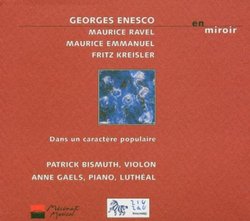| All Artists: Enescu, Bismuth, Gaels Title: Miroirs Members Wishing: 0 Total Copies: 0 Label: Zig Zag Territories Release Date: 12/31/2007 Genre: Classical Styles: Chamber Music, Historical Periods, Classical (c.1770-1830) Number of Discs: 2 SwapaCD Credits: 2 UPC: 3760009290129 |
Search - Enescu, Bismuth, Gaels :: Miroirs
CD Details |
CD Reviews"Truth without Authenticity" (Kreisler) - Art Music with a P Leslie Richford | Selsingen, Lower Saxony | 06/28/2008 (5 out of 5 stars) ""Dans un caractère populaire" (In popular style). Patrick Bismuth, violin, and Anne Gaels, Erard grand piano and luthéal, play music by Enescu, Ravel, Kreisler and Emmanuel. Track listing:
CD 1 (approx. 49 minutes) George Enescu: Sonata No. 3 Op. 25 for piano and violin, in three movements (Moderato malinconico; Andante sostenuto es misterioso - Allegro con brio, ma non troppo mosso) George Enescu: Impressions d'enfance [Impressions of Childhood], Op. 28, for violin and piano. CD 2 (approx. 51 minutes) Maurice Ravel: Tzigane ("Rhapsodie en Concert") for violin and luthéal. Fritz Kreisler: Nine original compositions and transcriptions (1. La Gitana; 2. Zigeuner-Capriccio; 3. Caprice viennois; 4. Schön Rosmarin; 5. Liebesleid; 6. Alter Refrain; 7. Tango after Isaac Albeniz; 8. Danse espagnol after Enrique Granados; 9. Danse espagnol from "La Vida breve" by Manuel de Falla. Maurice Emmanuel: Suite on Popular Greek Tunes, Op. 10, for violin and piano. Recorded on 21st and 22nd January 2001 at the Musical Instrument Museum in Brussels, Belgium (Ravel) and on 29th January through 8th February 2001 at the Bonsecours church in the 11th arrondissement of Paris, France. Released in 2001 as Zig Zag Territoires ZZT 010801/02. Total playing time: 100 minutes. (The two pieces by Enescu and Ravel's Tzigane have since been re-released at mid-price on a single CD: Violin Sonata; Ravel: Tzigane.) As a lover of "early" music, I seldom wax enthusiastic about 20th century compositions, but Patrick Bismuth, himself better known as a baroque violinist, has here completely changed my perspective and provided me with a joyful source of entertainment and wonderment by drawing on his own background in Southern and Eastern European and/or Middle East folklore to produce this absolutely wonderful recording of a number of pieces which were composed during the first half of the twentieth century as imitations of popular melodies and ways of playing the violin. "Popular" does not, of course, indicate that the melodies are anything like what modern Western ears might understand by the term: The first of the two discs, containing exclusively music by the great Romanian violinist and composer George Enescu (or Georges Enesco, as he was known in France), could be misunderstood by a casual listener as "caterwauling": Enescu draws on the traditions of Rumania and Moldavia, including the use of quarter-tones and glissandi, to create a beautifully evocative sonata which often, to my ears, has an oriental flavour, while his "Impressions of Childhood" reproduce in miniature some of the sounds he remembered from his early youth in Moldavia - including not only birdsong and a storm, but also the howling of the wind through the chimney! I first heard Enescu's Sonata No. 3 from a reissue of the 1930's HMV recording by Yehudi Menuhin, but I feel that it has only been Patrick Bismuth (and his congenial partner, Anne Gaels, who masters the devilishly difficult piano part with bravura) who has really opened up to me the rhythmic and melodic coherence of this amazing piece of music (the only other piece that can even slightly bear a comparison would be Balakirev's "Islamey", but that was written for piano solo). Bismuth's own background makes him, it would seem, an ideal interpreter of this kind of music, and he is ably assisted by sonics which are totally beyond reproach. The second CD is more of a "mixed bag". Ravel's "Tzigane" is here played in the original version for solo violin and "luthéal", a piano-like instrument of which there are very few surviving examples. Its sound varies between similarity to a fortepiano, to a harpsichord and to a cimbalom. Like Enescu, Ravel was not really interested in just reproducing gypsy music; instead he creates a "hommage" to this style using his own version of the sounds he remembered having heard. The nine pieces by Fritz Kreisler are, perhaps, the least exotic on this recording, and are partly described in the notes as "syrupy"; they reflect both Kreisler's half-serious, half-jocular personality and the atmosphere in post-Strauss Vienna, although here, too, there are gypsy pieces and also some transcriptions of Spanish dances. The second CD closes with a suite by Maurice Emmanuel, a French composer I had never heard of before. It is entitled "Suite on Popular Greek Tunes", but there is, of course, more to it than that: the piece appears to have originated out of Emmanuel's studies both of music in Ancient Greece and of folk melody on the Greek islands which lie nearest to Turkey, and there is also some Caucasian influence. All things considered, the nine-and-a-half minutes are surprisingly easy on the ears of a western listener and give Patrick Bismuth and Anne Gaels a further chance of showing off their prowess - a chance they gratefully accept! Obviously, this is not music for "everyman", however "popular" it may once have been. But anyone who is interested in the relationship between classical music and folk music, fans of Bela Bartok, and lovers of great violin playing should all find enough here to make them feel, as I do, that buying this set was an investment which repays itself over and over again at every listening." |

